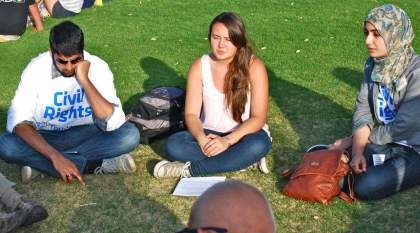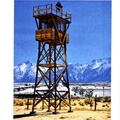Ever since I returned to San Diego from my first Manzanar Pilgrimage in 2010, I have been waiting to go back.
My first experience was extremely eye opening, and it brought to life what my Grandpa Harry had told me about his life there. Seeing the snow capped mountains he saw, walking the dusty paths, I would imagine him walking, and feeling the heat for only a day that he had to endure for the duration of the camp, was a very powerful experience, especially because I was very close to my Grandpa, and he had recently passed away.

Carly Lindley (center), shown here facilitating one of the small group discussions at the 2012 Manzanar At Dusk program, April 28, 2012, at Lone Pine High School, Lone Pine, California. (click to view larger image) Photo: Gann Matsuda
It was an experience that I wouldn’t even know how to put into words.
When people would say each Pilgrimage is a different experience, I never quite understood. How could coming back be a different experience, and why would I want that experience to change?
After two years, I expected to come back and feel the same feelings I did my first time, and I was looking forward to it. This year, I came back as part of the program putting together Manzanar At Dusk, as well as the organizer of the trip for the UCSD Nikkei Student Union, so already my trip was different from the first time I went as a freshman, just meeting the people I went with.
Being in these leadership positions this time around forced me to think about the Pilgrimage in a different way; instead of just going for my own reasons, I had to try to pass on my stories and feelings about Manzanar, and everything surrounding it, to the newcomers, and to everyone else who came. It was my job to pass down the importance of taking this pilgrimage so that they would want to continue returning, as I have.
Speaking as a small group facilitator, and at open mic for the first time, allowed me to put into words what I’ve always felt, and help me understand how I relate to everything much more. Manzanar isn’t just a part of my history and heritage. Rather, it is also a part the reason my life is the way it is today. I mentioned this in both small group and open mic, but this was the most important concept to me—I feel the need to reiterate it.
Part of the reason for Manzanar and the internment camps was to discourage Japanese culture and separate the people within this culture. However, I think that in those aspects, the camps ultimately failed to do what they were meant to do just by looking at my life now. On one hand, yes, they did dissolve part of the culture for a time. As a Yonsei, I do not speak any Japanese. I know my Grandpa was fluent in reading and writing, but I never heard or saw a word of Japanese from him. On the other hand, because I know my culture was discouraged and put down has given me the motivation to go back and rediscover it. I may not speak Japanese, but I’m learning.
In addition, instead of separating Japanese and Japanese Americans from each other, the camps, from my experience, have brought them closer. I know I cannot speak for the people who were interned and directly affected by camp, but in my generation, this is what I have seen. This idea is best exemplified by me and my college house mate. I did not know him until September of last year when we moved into the same house with two other people. After getting to know each other for a while, we found out that our families were both interned at Poston. But when I figured out that our families knew each other in camp, and remembered each other, for me it changed everything, and he was immediately part of my family. I didn’t have to know him for very long, but just that was enough for me to feel connected. These are the kinds of ideas that I gained from this year’s pilgrimage and I’ve enjoyed sharing.
Twenty of us travelled from San Diego, for some I was taking my second trip with them, and for others, I was introducing them to the Pilgrimage for the first time. I was excited to have so many people come and be interested in Manzanar and the history of Japanese Americans. I think I can speak for a lot of the members that came with UCSD NSU and say they enjoyed the experience, and I’m hoping they will return and gain a new understanding in coming years, as I plan to.
The views expressed are those of the author, and are not necessarily those of the Manzanar Committee.
*This article was originally published on the Manzanar Committee blog on May 9, 2012.
©2012 Carly Lindley



